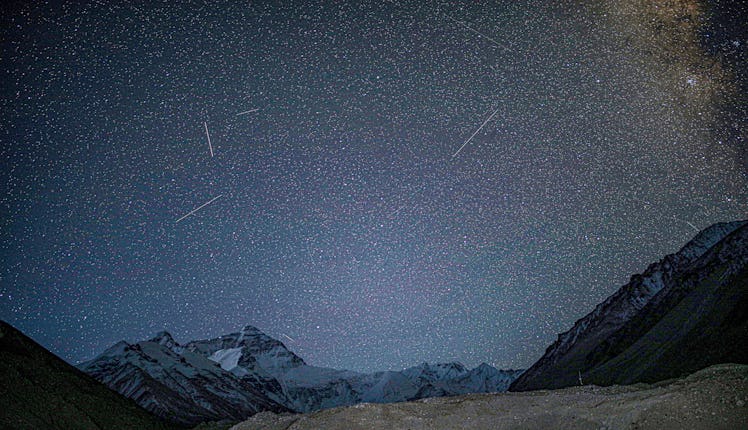Meteor "Storm" With 1,000 Shooting Stars an Hour Could Happen Tonight
A dazzling display of meteors might hit on Monday, May 30th.

In the nighttime hours of Monday, May 30th, a “meteor storm” (a more intense version of a meteor shower) might grace our skies nationwide. Might is the key word here — it could either be a dazzling display or not happen at all.
Some experts think it could even reveal something like 1,000 shooting stars an hour if it performs. Here’s what to know about the meteor shower, and how and when you should expect to see it.
What will make tonight be a dazzling shower — or “storm”?
Per Earthsky, for this meteor “storm” to totally wow us tonight, three things need to happen: 1) a large number of comet particles must have “been expelled from the comet’s orbit” during one of the times it shattered, 2) the comet breakup “would have had to push the material forward in its orbit,” making them speed up, and 3) the comet must eject material fast enough — at least 60 miles per hour — to be a decent storm.
Meteor “storms,” rather than regular old showers, happen when Earth passes through a very thick cluster of meteors, and because that could happen tonight, that’s why experts think we could see up to 1,000 shooting stars an hour tonight, per Washington Post.
Meteor storms have reportedly occurred a number of times in the past, mostly with the Leonids meteor showers, and have even brought up to 100,000 meteors an hour. This won’t be anything like that, but would still be quite the show.
What is the tau Herculid meteor shower/storm?
The tau Herculid comet was first discovered in 1930 (and is also known as the 73P/Schwassman-Wachmann comet) and has since shattered over the decades, but has since been “either non-existent or lackluster” when it crosses paths with Earth. Tonight is the first night it could really be a powerful show.
How can I watch the meteor shower/storm?
First: you don’t need any equipment, but you do need a dark, clear sky. That’s why it’s great news that we’re in the midst of a new moon, so the sky will be dark. If you have a cloudy night tonight, you might be out of luck.
Find a dark site to look at the sky, and let your eyes adjust to the darkness. Because the meteor shower will be in the North American skies, you don’t need to worry too much about finding the center of the shower, or radiant point.
The meteors will move slowly and might be dimmer than faster meteor showers.
Telescopes can help here if you have them, and Earthsky suggests you look for Comet SW3, which is “47 degrees west of the meteor radiant” and about 45 degrees high in the sky, and look for the stars around there.
When can I watch the meteor shower/storm?
Per Earthsky, three different teams calculated three different potential peaks for tonight’s meteor shower — one peak is on Monday night at about 1:04 a.m. EST for those in the Western hemisphere. Other predicted times include 12:55 a.m. EST or 1:17 a.m. EST.
But remember, the shower could not happen at all — or it could be absolutely dazzling.
“This is going to be an all-or-nothing event. If the debris from SW3 was traveling more than 220 miles per hour when it separated from the comet, we might see a nice meteor shower. If the debris had slower ejection speeds, then nothing will make it to Earth and there will be no meteors from this comet,” Bill Cooke, leader of NASA’s Meteoroid Environment Office wrote, per WaPo.